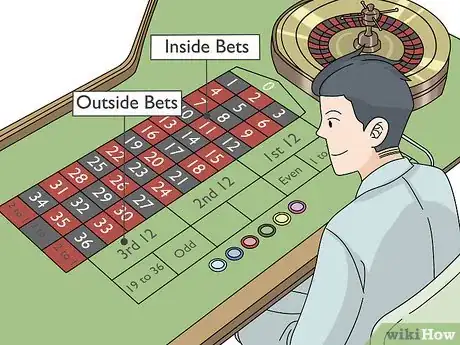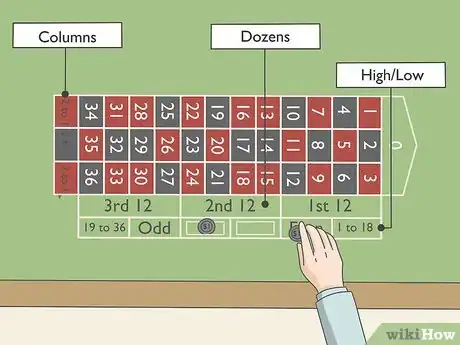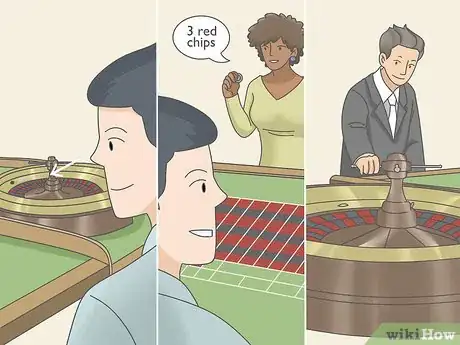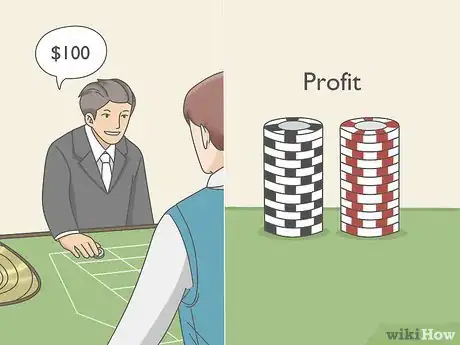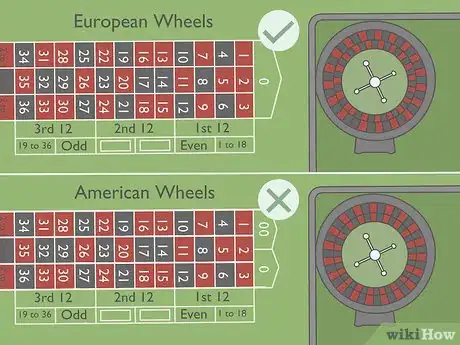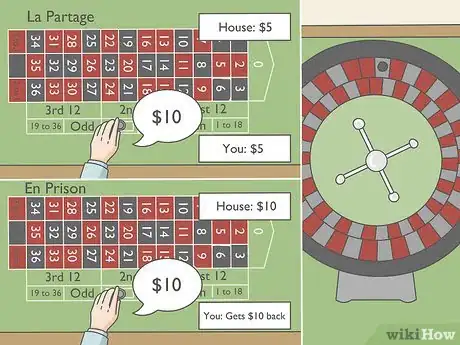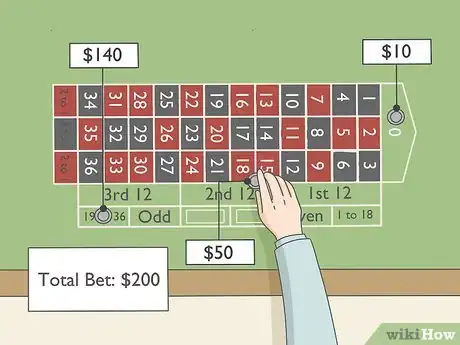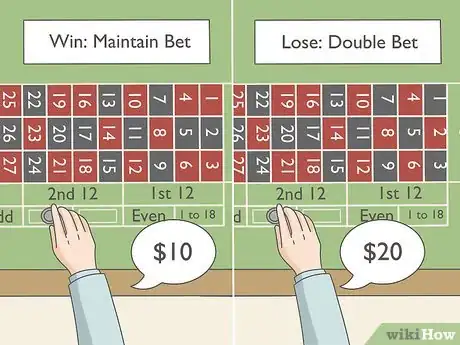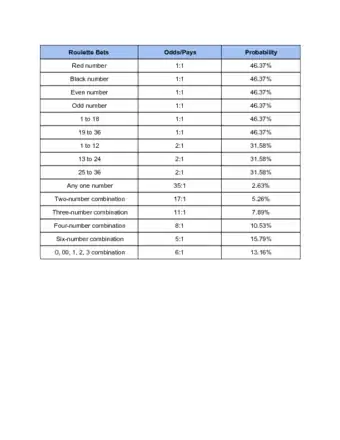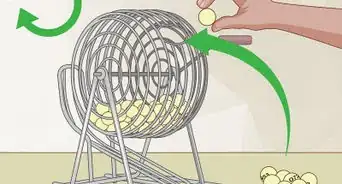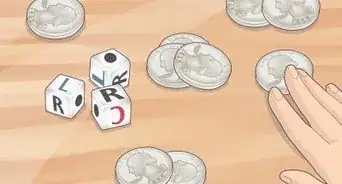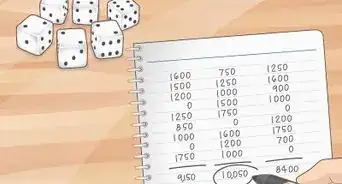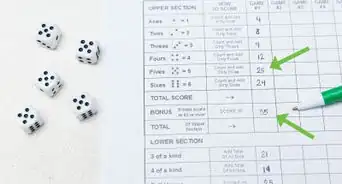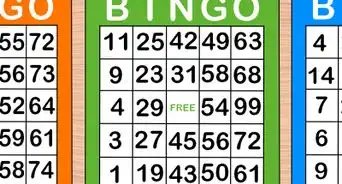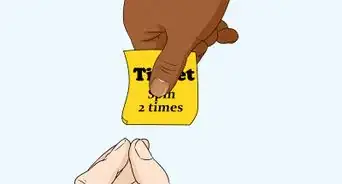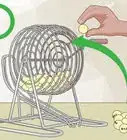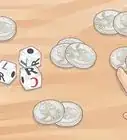This article was co-authored by wikiHow Staff. Our trained team of editors and researchers validate articles for accuracy and comprehensiveness. wikiHow's Content Management Team carefully monitors the work from our editorial staff to ensure that each article is backed by trusted research and meets our high quality standards.
There are 10 references cited in this article, which can be found at the bottom of the page.
wikiHow marks an article as reader-approved once it receives enough positive feedback. This article received 11 testimonials and 84% of readers who voted found it helpful, earning it our reader-approved status.
This article has been viewed 2,288,892 times.
Learn more...
Dating back hundreds of years, roulette is one of the oldest gambling games. While the game is based on chance, strict probabilities are at the core of the game's spinning wheel. There are ways of playing the game wisely and minimizing your losses, but the game is structured to give the house an edge. With that in mind, be cautious about strategies that make unrealistic guarantees. Remember to gamble responsibly, if you're making wagers, and have fun trying your luck on the wheel!
Steps
Placing Inside and Outside Bets
-
1Practice playing at a free table before placing actual bets. See if the casino has a free table, purchase one to play at home, or play on one online just to get a feel for the game. This will introduce you to the various bets involved in roulette. You can make several types of wagers on a roulette table, which is basically a 3-column chart that lists the 36 numbers on the wheel. The types of wagers are grouped into 2 categories:[1]
- Inside bets are wagers placed on specific numbers on the table. If you bet $1 on a number and the ball lands on that number, you win a 35:1 payout, or $35 plus your original $1 bet. You can also split your bet between up to 6 numbers that are next to each other on the table.
- Outside bets, such as even/odd and red/black, are lower risk, but the payout is only 2:1 or 1:1. There are blocks labeled with various bets on the table outside of the chart of numbers. This is why they're called outside bets, while wagers placed on the numbers are called inside bets.
-
2Make outside bets for better odds of winning. As long as you make the table minimum for each individual bet, you can make multiple outside bets to increase your odds of a payout. For instance, if you wager $1 on even and $1 on black, you’ll win a $2 payout if the ball lands on black 10, and you’ll break even if it lands on red 16. Along with even/odd and red/black, which offer payouts of 1:1, outside bets include:[2]
- High/low: Wagering that the ball will land on 1 through 18 or 19 through 36; the payout is 1:1.
- Dozens: Betting that the ball will land on 1 through 12, 13 through 24, or 25 through 36. The payout is 2:1.
- Columns: Betting the ball will land on a number within one of the table’s 3 columns; the payout is 2:1.
Advertisement -
3Bet on the inside in moderation to increase your payout. Though they have the highest payout, straight bets on a single number are risky. The odds of the ball landing on the exact number you chose is 1 in 37 (2.7%) for European wheels and 1 in 38 (2.63%) for American wheels. In addition to making a straight bet on a single number, you can also divide the odds between multiple numbers.[3]
- The payout decreases with the more numbers you split. A straight bet (1 number) yields a 35:1 payout, while a 6 line bet offers a 5:1 payout.
- When you split your wager, the numbers must occur next to each other on the roulette board within a 12-cell block. The exception is a 4 corners bet, in which you wager on the corner numbers of one of the table’s blocks.
-
4Observe the wheel, note people's wagers, and look for trends. Watch the croupier, or the casino roulette worker, spin the wheel and release the ball, observe the ball as it spins around the rim, and study other people’s wagers. Check for wheel biases, or numbers or sections where the ball repeatedly lands.[4]
- If people making wagers spin the wheel on their own, give it a spin yourself to get a feel for how fast it moves.
Tip: Numbers or sections that repeat may just be a coincidence. However, if the ball consistently lands in the section of the wheel opposite the one it was thrown, the wheel might be rigged or tilted.
Minimizing Your Losses
-
1Stick to your profit goal and loss limit. When it comes to roulette and any other gambling game, you should only bet an amount that you know you can afford to lose. Once you've decided how much money you're willing to lose, stick to that amount and don't be tempted to bet any more. Things can get out of hand quickly, especially with a game that goes so fast.[5]
- Additionally, don’t get too ambitious when it comes to profiting off of a roulette table. Set a low profit goal, such as 5% of your total wagers.
- To avoid temptation, limit the amount of alcohol you consume, write your maximum acceptable losses on a piece of paper to hold yourself more accountable, and ask a friend to keep tabs on you.
-
2Decrease your bets over time to protect your profits. If you start off betting $100 and end up with $150, withdraw your profit ($50) instead of adding it to the next wager. Continue playing with the same $100 to limit your maximum loss to $50.[6]
- The more you win and withdraw your money, the more likely it is that you’ll at least break even.
-
3Remember that the house always has an advantage. Since the maximum payout is 35:1 instead of 37:1 or 38:1, the house always has an edge. Additionally, recall that there's a 0 pocket in European wheels and an extra 00 pocket on American wheels. This means that, even if you pick a “safe” red/black or high/low bet, you still have less than a 50% chance of winning, since 0 and 00 are green (not red or black) and don't count as low in a high/low bet.[7]
- Suppose you bet $1 on the same number on a European wheel 37 times. If the odds play out, you’ll lose 36 times and you’ll land on that number once. You’ll end up losing $36, but you’ll only make $35 in winnings, so your net gain is -1. This gives you a house edge of -2.7% (-1 ÷ 37 = -0.027) .
- Similarly, since there are 36 numbers and a 0 pocket on a European wheel, you have a 51.35% chance of losing if you bet on black. Say you bet $1 on black for 37 spins; if the odds play out, you’ll win $18 and lose $19. Again, you have a profit ratio of -1 to 37, or -2.7%.
- This means that, no matter which type of bet you place, you're more likely to end up losing money to the house because of how the game is structured.
-
4Play on European wheels instead of American wheels when possible. The American Roulette wheel has an extra slot, 00, which decreases the odds of winning. One pocket may not seem like a big deal, but the impact on probability is drastic. On an American wheel, the house advantage is twice that of a European wheel, which means you could lose money twice as fast.[8]
- Recall that, on a European wheel, the house edge is 2.7%. If you bet $1 on the same number for 37 spins and the odds play out, you’ll end up with a net profit of -$1 ($35 in winnings and $36 in losses).
- On an American wheel, if you bet $1 on the same number for 38 spins (accounting for the extra pocket), you’ll end up with $35 in winnings and $37 in losses, or a net profit of -2. That gives you a house edge of -5.26% (-2 ÷ 38 = -0.0526), which is twice that of a European wheel's -2.7% edge.
-
5Keep in mind probability is a trend with no short-term guarantees. The real trick to roulette is to get lucky, then quit while you’re ahead. Every spin has a 1 in 37 (for European) or 1 in 38 (for American) chance of landing in a given pocket. Each spin is an individual trial with its own odds but, the longer you play, the more likely it is that you’ll fall into the probabilities that structure roulette.[9]
- Over the course of a few spins, there’s no guarantee that one spin will be red and the next will be black. The ball could land on a black pocket 5 times in a row despite the roughly 50:50 odds of landing on red or black.
- For another example, try flipping a coin. If you flip it 3 times, you may very well land on heads 3 times in a row. However, if you flip it 100 times, it’s more likely that you’ll flip heads and tails around 50 times each.
Bottom Line: Since probabilities play out over time, the likelihood of losing to the house increases over time. If you bet on red and win 5 times in a row, quit while you’re ahead before you blow your winnings.
Using Common Betting Strategies
-
1Try your hand at guessing the ball’s bounce. As the ball spins in the rim around the wheel, notice when it moves past a fixed point, such as the wheel's 0 pocket. Try to guess when the ball will slow down, fall from the rim, and start bouncing off of the deflectors that divide the wheel’s pockets. It’s difficult but, with practice, you may be able to guess which section of the wheel the ball will land after it stops bouncing.[10]
- If you can guess before the croupier, or the casino worker, calls last bets, you can wager on the section of the wheel where you think the ball will land.
- Recall that it’s easier to predict where the ball will land if the wheel is tilted. If there’s a slight tilt, the ball is more likely to land on the side opposite where the croupier released it into the spinning wheel.[11]
Did You Know: There are computer programs that use cameras and physics equations to calculate where the ball will stop bouncing. However, keep in mind you could get in trouble for using prediction software in an actual casino.
-
2Take advantage of La Partage and En Prison rules on a European wheel. Generally, La Partage and En Prison are only played on European wheels. In La Partage, if you make a 50/50 bet (such as that the ball will land on an even number) and the ball lands on 0, you and the house split your bet.[12]
- Let's say you bet $10 on black. If the ball lands on zero, the house keeps $5 and gives you back $5. It’s not a win, but it's better than losing the entire $10 bet.
- En Prison works similarly. Suppose you bet $10 on black and the ball lands on 0. The house keeps your $10 and spins again. If the ball lands on black, you get your $10 back. You don't win anything, but you don't lose your $10!
-
3Go with the Fibonacci System for a low-reward, low-risk strategy. In this system, you place wagers only on the roughly 50/50 bets (such as odd/even), and you base your wagers on the Fibonacci numbers. If you lose in the first round, make your next wager the next number in the Fibonacci sequence in the second round. Keep advancing a number in the sequence until you win then, when you do win, go back 2 numbers in the sequence.[13]
- The Fibonacci numbers are a sequence in which a number is equal to the sum of the 2 numbers before it. The first part of the sequence is 1, 1, 2, 3, 5, 8, 13, 21, 34, 55, and 89. To figure out what comes next, just add the last 2 numbers in the sequence: 55 + 89 = 144.
- Suppose you start with a $1 wager and lose 4 times in a row. So far, you’ve lost a total of $7 ($1 + $1 + $2 + $3 = $7). You win when you wager $5, so you get the original $5 bet back plus the $5 payout. Then, you'd count back 2 steps in the sequence from 5 and wager $2 in the next round. Lowering your wager every time you win helps protect your profits.
- The Fibonacci strategy is a pretty safe strategy, but low risk means low profits. Additionally, remember that house always has an edge of 2.7% (for a European wheel) or 5.3% (for an American wheel), and no mathematical system or betting strategy can defeat that.
-
4Use the James Bond Strategy no more than once or twice. This system involves dividing your wager between high numbers, a 6 line bet, and 0. For instance, if you’re betting $200 total, you’d wager $140 on the high numbers (19-36), $50 on the numbers 13-18, and $10 on zero. This increases your likelihood of winning by spreading out your bets.[14]
- This strategy is based on a $200 total wager; keep your proportions if your making a wager other than $200. For instance, divide a $20 bet in to $14, $5 and $1 wagers. If you're betting $40 total, make divided wagers of $28, $10, and $2 (20 x 2 = 40, so multiply the divided bets by 2).
- If the number is between 19 and 36, you will have an $80 profit; if the number is between 13 and 18, you will have a $100 profit, and if the number is zero, then you will have a $160 profit.
- No strategy is foolproof. Since odds tend to even out over time, the house still has an edge. Even if you place bets on half the board, you’re still more likely to lose money over time.
- Additionally, there’s no guarantee that the ball won’t land on a number between 1 and 12 several times in a row. Suppose that happens for the first 5 spins. If you wagered $200 per spin, you just lost a quick $1000!
-
5Steer clear of the high-risk Martingale Strategy. For this strategy, you start by wagering the table minimum on a 50/50 outside bet. You keep betting that amount until you lose. When that happens, you double your bet for the next spin and keep doubling your bet until you win. While doubling your bet may help you recover the money you lost, it’s an extremely risky strategy.[15]
- Say you bet $10 on red and lost. You’d bet $20 in the next round and, if you win, you’d more than make up for your $10 loss in the previous round. The problem with this strategy is that a losing streak could quickly leave you bankrupt.
- In a series of 4 spins, there’s no guarantee that the ball will land on red twice and black twice, even if the odds are roughly 50/50. You could bet on red 4 spins in a row and the ball could land on black each time.
- Suppose you bet $10, lose 4 times in a row, and double your bets each spin to $20, $40, and $80. If you have only $150 to spend, you’ll have blown through your entire bankroll before you have a chance to recover your losses.
Types of Roulette, Payouts, and Strategies
Community Q&A
-
QuestionIs picking black or red on a flip of a coin a good strategy?
 Abraham Murciano BenzadonCommunity AnswerIt doesn't really matter if you pick red or black, since they both have the same probability of appearing. Flipping a coin will not do any more for you than just picking black or red without flipping a coin. The degree of randomness is the same.
Abraham Murciano BenzadonCommunity AnswerIt doesn't really matter if you pick red or black, since they both have the same probability of appearing. Flipping a coin will not do any more for you than just picking black or red without flipping a coin. The degree of randomness is the same. -
QuestionHow do I go about dealing with the 0 and 00 in the James Bond method when playing American Roulette?
 Community AnswerBetting on the split of 0 and 00 would make you lose $25 if they came in. You would need to bet one and hope the other, nor 1-12, come in or you'll lose the full $200.
Community AnswerBetting on the split of 0 and 00 would make you lose $25 if they came in. You would need to bet one and hope the other, nor 1-12, come in or you'll lose the full $200. -
QuestionIs red or black the dominant color on a roulette wheel?
 Community AnswerThey are equal in that there are 18 red and 18 black numbers on a roulette wheel. The 0 and 00 are both green numbers. However, there are 10 odd red numbers and 8 even red numbers. Also,the opposite is true in that there are 10 even black numbers and 8 odd black numbers. If you bet even and red or odd and black it seems you would have a slight edge as you would be covering 20 numbers instead of 18.
Community AnswerThey are equal in that there are 18 red and 18 black numbers on a roulette wheel. The 0 and 00 are both green numbers. However, there are 10 odd red numbers and 8 even red numbers. Also,the opposite is true in that there are 10 even black numbers and 8 odd black numbers. If you bet even and red or odd and black it seems you would have a slight edge as you would be covering 20 numbers instead of 18.
Warnings
- Always gamble responsibly. Never bet more money than you know you can afford to lose.⧼thumbs_response⧽
References
- ↑ https://www.roulettephysics.com/how-to-win-at-roulette/
- ↑ https://gaming.unlv.edu/casinomath.html
- ↑ http://theconversation.com/can-maths-help-you-win-at-roulette-69440
- ↑ https://digitalscholarship.unlv.edu/cgi/viewcontent.cgi?article=1414&context=gaming_institute
- ↑ https://www.roulettephysics.com/how-to-win-at-roulette/
- ↑ https://www.roulettephysics.com/how-to-win-at-roulette/
- ↑ https://gaming.unlv.edu/casinomath.html
- ↑ https://gaming.unlv.edu/casinomath.html
- ↑ http://theconversation.com/can-maths-help-you-win-at-roulette-69440
- ↑ https://www.insidescience.org/news/physics-knowledge-can-tilt-odds-roulette
- ↑ https://digitalscholarship.unlv.edu/cgi/viewcontent.cgi?article=1414&context=gaming_institute
- ↑ https://www.realmoneyaction.com/roulette/the-en-prison-and-la-partage-roulette-bets-explained/
- ↑ https://www.youtube.com/watch?v=KdO_CtbdjVY
- ↑ https://www.youtube.com/watch?v=v5KbPzo3eUs
- ↑ https://www.youtube.com/watch?v=U29SK0YdYTI
- ↑ https://www.pbs.org/wgbh/pages/frontline/shows/gamble/odds/odds.html
About This Article
To win at roulette, watch the wheel for a few turns before you place your bet. If you see any patterns, such as a high frequency of odds, you can use those to influence your bet. If you are given the choice between European and American roulette, choose European, which offers slightly higher odds of winning. Minimize your losses by betting the outside, such as red versus black or odd versus even. You can also follow the James Bond strategy by placing $140 on numbers 19-36, $50 on 13-18, and $10 on zero, so the only way you can lose is if number 1-12 comes up. For more information, like how to set a budget while betting on roulette, keep reading!
